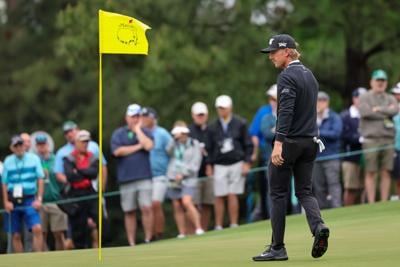AUGUSTA -- It was both later than scheduled and earlier than feared, but the start of the 88th Masters Tournament arrived Thursday morning at Augusta National Golf Club.
Turbulent weather loomed in the forecast all week long, and even as late as Wednesday evening it appeared that the first round may not start until the afternoon due to heavy rains and dangerous wind gusts.
Augusta dodged most of the heavy stuff, and after a delay of about 2½ hours it was more or less back to business as usual at the Masters.
That delay meant the entire field couldn't complete the first round before sundown Thursday, so those who didn't finish will have to play their last few holes Friday morning before beginning round two.
Players may find a different challenge awaits Friday compared to Thursday. The wind often plays a key role at the Masters, and its effect will be seen this week in two ways - one in how it changes the players' shot-shaping and distance control, the other in how it will team with the underground SubAir Systems to dry out the course for the rest of the week.
The opening tee shots of the week were played into a strong helping breeze, leaving less-than-full wedges into a first hole that is anything but a friendly handshake of an opening par-4 - No. 1 is the sixth-toughest hole at Augusta National in Masters history, and some of its recent hits include Ernie Els' six-putt 9 in 2016 and eventual champion Jon Rahm's four-putt double bogey in the first round last year.
The flagstick whipping in the wind represented another challenge for those players - how to control their distance into a difficult green, where anything short of the massive false front falls off the green and anything long leaves a delicate chip back down toward the flag.
Masters rookie Jake Knapp was too strong with his approach, landing it pin-high and then watching as it bounded over the back of the green before converting a crafty up-and-down for par. Danny Willett, the 2016 Masters champion, landed his approach from a similar distance short of the hole to set up a good look at birdie. Bryson DeChambeau laid off on his tee shot, only hitting it 299 yards to leave a 145-yard approach that he hit to 6 feet for his first of three consecutive birdies.
The swirling winds above the par-3 12th hole are perhaps the most famous in golf, but they're not the only ones that could have a say in who leaves Sunday with the green jacket.
"I think people may not realize how difficult the golf course is, especially when the wind is blowing," world No. 1 and 2022 Masters champion Scottie Scheffler said Tuesday. "And I think we're going to have another couple days of wind here where the winds are going to be pretty high and it swirls like crazy around this place."
The players knew that had to be part of their strategy coming into the week, requiring even more patience - and a shorter memory - than in years with calmer conditions.
"Yeah, when the wind is swirling here it's very hard," Ireland's Shane Lowry said. "Sounds like going to be a tricky Masters and scoring is going to be quite difficult. I don't mind that. Ready for the challenge."



